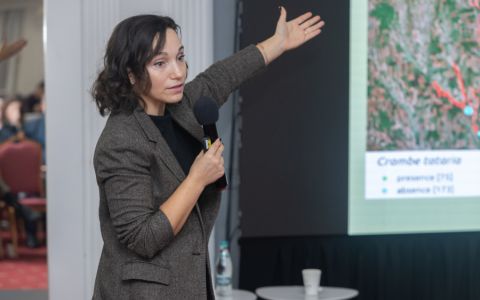Prague (Arnika) – Seven years ago in Stockholm a global treaty was signed for the reduction of hazardous Persistent Organic Pollutants (POPs). Arnika prepared various events to remind the public of this anniversary,which will be held in six cities in the Czech Republic, and also, a map „Perzistentní organické látky v České republice (Persistent oraganic pollutants in the Czech Republic) will be distributed. A series of information stalls is prepared for the 22nd of May to inform the public about the PVC risks in connection with The Stockholm Convention. This material greatly contributes to POPs creation.
„Highly dangerous dioxins are created when PVC is burnt. The Stockholm Convention suggests substitution of materials like PVC as a solution for how to prevent dioxins and other POPs from escaping. Arnika also appeals for the substitution of PVC,“ head of the campaign Future without toxins Jindřich Petrlík explains the connection between the anniversary of The Stockholm Convention and the petition „For PVC substitution“.
The Stockholm Convention is legally binding for the signatory states to reduce production, usage of selected substances and their disposal into the environment. So far, the treaty includes 12 toxic substances which are hard to degrade in the environment and accumulate in bodies of animals, including man. „ Apart from others, this group involves dioxins, hexachlorbenzene or polychlorinated biphenyls (PCBs), created as by-products during processes of production and liquidation of PVC,“ said head of the campaign Do Not Play with PVC Miroslava Jopková.
Jopková points at release of hazardous substances connected with another phase of PVC life cycle: „ Phtalates and adipates are PVC softeners and can leak out during using. Some of them can cause harm to hormonal system, reproduction and weaken immunity,“ added Jopková. That is why Arnika attempts to reduce PVC in areas where health of consumers is in jeopardy. This concerns mainly toys and products for children, sanitary products and food packaging. These requirements are also part of the petition „ For PVC substitution“, available to sign up at the happening. Until today 7500 people in the Czech Republic have signed up the petition, including number of celebrities.
„There are many possibilities how to reduce PVC and other substances jeopardizing the environment. Substitution of these materials by safer alternatives everywhere possible is the best thing to do. By this the risk of dioxins creation during waste burning will be reduced greatly, whether in households, landfills, cement works or at incineration plants,“ reminded Petrlík.
Information stalls of Arnika will stand in these cities: Praha, Děčín, České Budějovice, Jihlava, Chotěboř, and Ostrava. Arnika´s activities in this project were supported by grant provided by Iceland, Lichtenstein, Norway and by the EEC Financial Mechanism and Norwegian Financial Mechanism by NROS (Foundation for Development of Civil Society) and by grant of the Prague City Hall.
(1) Informtion stalls of Arnika will stand on May 22 at these spots: Děčín: In front of the department store Korál. Plzeňská street, Podmokly, from 13-17 hours, contact: Kamil Repeš, mobil phone: 777 113 237. České Budějovice: Piaristické náměstí from 13:30 – 15:30 hours, contact: Oldřich Jarolím, mobil phone: 724 115 436. Chotěboř: T.G.Masaryk Square from 13:30 – 15:30 hours, contact: Matěj Man, mobile phone: 724 115 436. Jihlava: Jan Masaryk street, in the park opposite grammar school and technical college 11 – 17hours, contact: Jana Vitnerová, mobile phone. 775 315 818. Ostrava: centre of Ostrava, Masaryk square, 14 a 17.hours, contact: Vendula Kubačáková,mobile phone: 776 756 352. Prague: Vítězné náměstí in front of the area of ČVUT Prague, 14 do 18hours, contact: Renata Konupková, mobile phone: 774 244 936. (1) The relationship between burning PVC in wastes in case of Malešice incineration house of communal waste, from which the leak of dioxins into the air does not happen anymore, but a huge amount of it still ends up in fly-ashes coming from combustion gas refinment, is now topical in Prague. Potential of fires at the communal waste landfill in Chabry can also present another possible source of escape of dioxins. Dioxins were undoubtedly created by the fire at hotel Olympik on May 26 in 1995 or at the distribution point in Žižkov in December in 2002, PVC cabels were burnt there. (2) In the south of Bohemia there are still very topical fires at a waste dump Lišov and also at their illegal store in Vráto near české Budějovice. In both cases PVC was also burnt, therefore escape of dioxins into the air was highly probable. (3) There are two incineration plants in Jihlava, where dioxins are created by burning chlorinated substances. Currently most of them end up in fly-ashes coming from combustion gas refinment, but part of them still escapes into the air. Apart from that, last year there was a fire at the communal waste dump in Vyskytná. There is a high probability that also there hazardous dioxins were created on account of PVC presence in the communal waste. (4) In the Ostrava region the main source of dioxins' escape are metallurgical works, but there is also located an incineration plant of hazardous wastes, which partly burns sanitary waste containing a very high percentage of PVC from used sanitary products. Very dangerous dioxins are created by its burning. During processing of scrap metal in metallurgical works there can also be created dioxins due to PVC parts present connected with it. Copper wires with PVC insulation present the biggest problem. Therefore documents of the Stockholm Convention recommend to separate PVC from the processed scrap metals.






